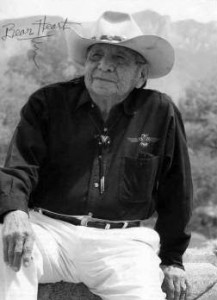Learning how to think
 This is an excerpt from The Wind Is My Mother about learning how to think. Bear Heart speaks:
This is an excerpt from The Wind Is My Mother about learning how to think. Bear Heart speaks:
Native American children got a very well-rounded education from our elders. We didn’t just learn about hunting and legends.
One elder once sat down three of us boys who had just reached puberty and asked a theoretical question: “Suppose you were married and your wife and child were about to drown in the river. Which one would you save?”
One answered, “I’d save my wife.”
“Why?” He had to give a reason right there.
“The child is innocent and in its innocence it can go on. My wife and I could always have another child.”
Then the elder turned to another. “What about you? Which one would you save?”
“I’d save my child.”
“Why?”
“My wife and I would already have had our life together and the child needs a chance to live its life.”
“What about you?”
I answered, “I love my child in a very special way and in another special way I love my wife. We might all drown together but I’d try to save both.”
None of these answers was right or wrong. What this elder was doing was teaching us how to think, set priorities and give reasons why.
Reflections of ourselves
Jonas Bear once took me down to a pond and told me to look into it, asking, “What do you see?”
“I see my reflection.”
“Put this stick in the water and stir up your reflection.”
After I stirred it up, he asked, “Now what do you see?”
“My face is all distorted.”
“Do you like what you see?”
“I know that it’s not supposed to be that way.”
“When you meet someone and you immediately dislike them, always remember you are seeing a reflection of yourself — there is something you don’t like about yourself that you’re not owning up to. When you see it in someone else, then you don’t like that person but in reality you are being displeased with yourself. Always remember that.”
He was not a psychology teacher. He’d never even heard the word “psychology.”
Along with that teaching he said, “Some children are born deformed, perhaps without arms or legs, or disfigured on their face somehow. Maybe one side of the eye is totally missing, all covered up with flesh. It’s our teaching, and we’re very strict about it, to never stare at someone who is deformed. Just look to one side and try not to keep looking at them.
Accept the child. They may look different, but they’ve got a heart just like you have, they have feelings just like you have. Play with them. Make them laugh if you can.”
When a child was born deformed, our people said it was especially blessed — it would attract the attention of good people and create a lot of love. Not just sympathy, but love, so that it could grow into a useful life in spite of that deformity.
So everyone seemed to pitch in and support the family as well as the child. That was part of our real strict teaching about not staring.
Molly Larkin is the co-author of the international best-seller “The Wind Is My Mother; The Life and Teachings of a Native American Shaman” and other books on health. She is passionate about helping people live life to their fullest potential through her classes, healing practice and blog at www.MollyLarkin.com

